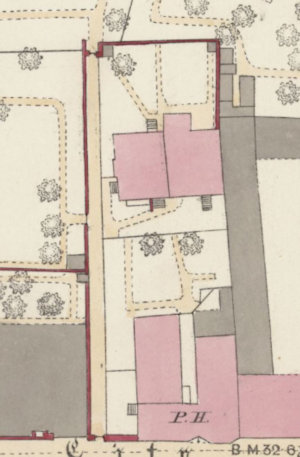 |
Dedication: Saint Radegund Location: Canterbury Coordinates: 51.28288N, 1.08191W Grid reference: TR150582 Status: destroyed |
 |
Dedication: Saint Radegund Location: Canterbury Coordinates: 51.28288N, 1.08191W Grid reference: TR150582 Status: destroyed |
St Radegund was a 6th century deaconess and strict ascetic. Although many English churches became dedicated to her, she never actually visited England, and certainly does not have a local connection to Canterbury. However, following the martyrdom of the famed Thomas Becket, Canterbury became the largest centre of pilgrimage in England, and many pilgrim hospices were set up to accommodate travellers. Among these was St Radegund's Hospice, which occupied the same site as St Radegund's Baths. The bathing facilities, which are said to have been fed by a natural spring, were almost certainly first constructed for the use of those staying at St Radegund's Hospice, likely primarily for sick or injured pilgrims.
Despite the fact that the well almost certainly gained its dedication to St Radegund at the time of the hospital's creation, it is possible that the baths were originally part of a Roman construction. In 1899, it was noted in the British Association for the Advancement of Science's Handbook to the City of Canterbury that the place was "supposed from remains found there, to have been a Roman bath". Unfortunately, I have been unable to find any details about what exactly these "remains" were like, but it is, nonetheless, quite possible that the well was once used by the Romans.
Following the Reformation and the cessation of pilgrimage to places such as Canterbury in the early 16th century, St Radegund's Hospice seems to have either been taken down or converted into something else. St Radegund's Baths, however, survived, and by the late 18th century it was a popular cold bathing facility. According to William Gostling, writing in 1796 in A Walk in and About the City of Canterbury, the site was so popular with bathers that it was "re-edified" in 1794: the original (and possibly medieval) bath was "deepened and enlarged", and divided into two separate, but "very commodious", cold baths, one measuring "18 feet by 16", and the other "18 feet by 6 feet 6 inches". Gostling also reported that the whole complex was "covered with arched roofs, and lighted only from the top by turrets".
Several decades previously, in an earlier edition of A Walk in and About the City of Canterbury from 1774, Gostling had already described the site, prior to its "re-edification":
|
That part on the right hand is called Duck-lane, and leads to St. Radegund's bath, a fine ſpring, built over, and fitted for cold bathing; the baſon or bath itſelf being twenty feet long, eleven feet wide, and from three to four feet deep. A dwelling-houſe adjoins of modern ſtructure, but in altering a very ancient one, near the bath, ſome hollows or pipes were diſcovered, carried along in the thickneſs of an old ſtone wall, which ſeemed a contrivance for heating the room in former times, and making a ſudatory or ſweating room of it. |
Although still in use, the baths seem to have been much less popular by the close of the 19th century. According to the previously mentioned Handbook to the City of Canterbury (1899), the site was noted for its "sweet" water, but clearly not for any efficacy in curing illnesses or even for the coldness of its water. The decrease in the baths' popularity was doubtlessly what motivated the demolition of the site in 1926, after which, if the Historic Environment Record is to be believed (Kent's version of it appears to be quite accurate), it was replaced by a warehouse, which can be seen on old air photography of the area.
Today, only scant remnants of the medieval hospice's walls reportedly survive in the garden of a house on its site.
Images:
Old OS maps are reproduced with the permission of the National Library of Scotland
Copyright 2025 britishholywells.co.uk